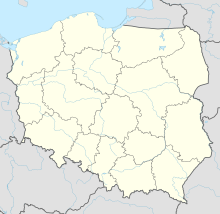
Back Вавелски кралски замък Bulgarian Castell de Wawel Catalan Královský hrad (Krakov) Czech Κάστρο Βάβελ Greek Castillo de Wawel Spanish Wawelgo gaztelua Basque دژ واول Persian Wawelin linna Finnish Château du Wawel French טירת ואוול HE
| Wawel Royal Castle | |
|---|---|
 The Wawel complex, with the cathedral on the right and the castle on the left. | |
| Type | Castle residency |
| Location | Old Town, Kraków, Poland |
| Coordinates | 50°03′14″N 19°56′05″E / 50.05389°N 19.93472°E |
| Area | 7,040 m2 (0.704 ha) |
| Built | 13th and 14th centuries |
| Architectural style(s) | Romanesque, Gothic, Renaissance, Early Baroque |
| Visitors | 2,100,000 (in 2019)[1] |
| Website | Official Website |
| Official name | Historic Centre of Kraków |
| Type | Cultural |
| Criteria | IV |
| Designated | 1978 (2nd session) |
| Reference no. | [1] |
| Country | Poland |
| Region | Europe and North America |
Location of Wawel Royal Castle in Central Kraków | |
The Wawel Royal Castle (Polish pronunciation: [ˈvavɛl] ; Zamek Królewski na Wawelu) and the Wawel Hill on which it sits constitute the most historically and culturally significant site in Poland. A fortified residency on the Vistula River in Kraków, it was established on the orders of King Casimir III the Great[2] and enlarged over the centuries into a number of structures around an Italian-styled courtyard. It represents nearly all European architectural styles of the Medieval, Renaissance and Baroque periods.
The castle is part of a fortified architectural complex erected atop a limestone outcrop on the left bank of the Vistula River, at an altitude of 228 metres (748 ft) above sea level.[3][4] The complex consists of numerous buildings of great historical and national importance, including the Wawel Cathedral where Polish monarchs were crowned and buried. Some of Wawel's oldest stone buildings can be traced back to 970 CE, in addition to the earliest examples of Romanesque and Gothic architecture in Poland.[5][6] The current castle was built in the 14th century, and expanded over the next hundreds of years. In 1978, Wawel was declared the first World Heritage Site as part of the Historic Centre of Kraków.
For centuries the residence of the kings of Poland and the symbol of Polish statehood, Wawel Castle is now one of the country's premier art museums.[3] Established in 1930, the museum encompasses ten curatorial departments responsible for collections of paintings, including an important collection of Italian Renaissance paintings, prints, sculpture, textiles, among them the Sigismund II Augustus tapestry collection, goldsmith's work, arms and armor, ceramics, Meissen porcelain, and period furniture. The museum's holdings in oriental art include the largest collection of Ottoman tents in Europe. With seven specialized conservation studios, the museum is also an important center for the conservation of works of art. With over 2.56 million visitors in 2023, Wawel Castle is the most visited art museum in Poland and the 20th most visited art museum in the world.[7]
- ^ Głowicka-Wolska, Redakcja, Eliza. "Zoo Wrocław – rekord frekwencji w 2015: lepiej od Wawelu i Wieliczki – www.wroclaw.pl". Retrieved 6 May 2017.
- ^ "Castles.info – Krakow castle, Wawel". www.castles.info. Retrieved 6 May 2017.
- ^ a b History of Wawel Hill Archived 3 April 2016 at the Wayback Machine at wawel.krakow.pl Archived 9 January 2007 at the Wayback Machine
- ^ Urban, Dr. Jan. "Geological foundation of Kraków". www.cracow.org.uk. Archived from the original on 21 May 2008.
- ^ Świechowski, Zygmunt. "Stan wiedzy na temat chronologii wczesnej architektury monumentalnej w Polsce po pięcioletnich badaniach przy zastosowaniu metody 14C". Kwartalnik architektury i urbanistyki. Archived from the original on 27 February 2017.
- ^ Kozakiewicz, p 287.
- ^ Cheshire, Lee; da Silva, José (27 March 2023). "The 100 most popular art museums in the world—who has recovered and who is still struggling?". The Art Newspaper. Research conducted by Alex Colville and Justin Kamp. Retrieved 7 April 2023.

